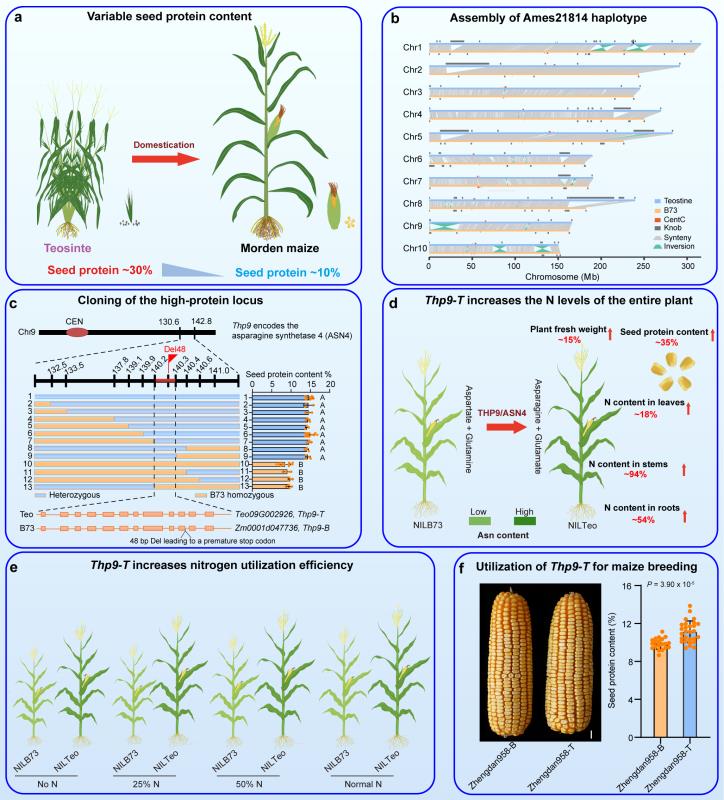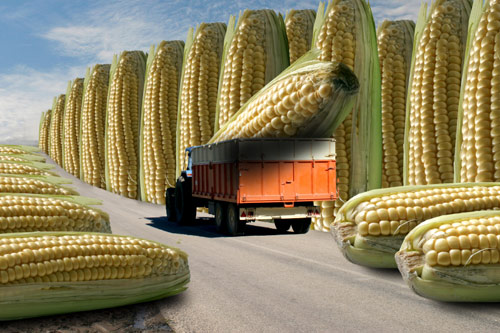Total seed protein in modern hybrid and inbred varieties of corn is three times lower than that of its wild ancestor, teosinte. The reasons were unknown, until now.
A gene on chromosome nine called THP9 (teosinte high protein9) that encodes an enzyme important in nitrogen metabolism (asparagine synthetase 4) is highly expressed in teosinte, but not in an inbred modern strain of corn (B73), scientists at the Chinese Academy of Sciences (CAS) reported in an article in the journal Nature on November 17, 2022.
“This might be one of the factors that leads to differences in nitrogen assimilation,” said Wu Yongrui, PhD, a researcher at the CAS Center for Excellence in Molecular Plant Sciences. “Amino acids are essential substrates for protein synthesis, and their levels in the plant are influenced by soil nitrogen availability and the nitrogen use efficiency of the plant.”
In B73, a deletion in an intragenic non-coding segment (intron) results in incorrect splicing of the THP9 mRNA.
“Because modern maize was domesticated from teosinte, we reasoned that characterizing the genes responsible for the high-protein trait in teosinte might reveal a more diverse set of QTLs [quantitative trait loci] than those found in recent inbred maize populations,” said Yongrui. “The results might also help us to understand the reasons for the decrease in seed protein content during the domestication of maize.”
The investigators used a method called “trio binning” to piece together teosinte’s haplotype DNA sequence—the group of alleles that are inherited from a single parent. Variations in alleles make it difficult to assemble haplotype sequences from diploid genomes. Trio binning simplifies haplotype assembly by resolving allelic variations before assembly.
When the investigators experimentally introduced teosinte’s THP9 (THP9-T) gene into the B73 genome, it significantly increased the seed protein content in the transgenic inbred strain. By backcrossing modern inbred corn strains and hybrids—a process called introgression—the researchers introduced teosinte’s THP9 into modern corn strains. This greatly increased total protein content in corn seeds as well as free amino acids throughout the plant, particularly in the amino acid asparagine. Importantly, the increase in protein content did not affect the yield of the plant.

“There is economic and environmental pressure to maintain high-yielding maize [corn] while reducing the level of nitrogen applied to the soil,” said Yongrui. “Therefore, it is crucial to identify genetic factors that increase nitrogen-use efficiency.”
While modern corn varieties contain 5–10% protein, teosinte contains 20–30% protein in seeds. This decrease in seed protein in corn has resulted from plant breeding practices over millennia that have prioritized other facets such as starch content over protein content and flavor. The use of nitrogen fertilizer further reduced the importance of seed nitrogen content.
Yongrui said, “Our research shows the possible value of hybrids that contain the THP9-T allele, although larger field trials in multiple geographical locations will be needed to fully establish its potential for improving seed protein content and nitrogen-use efficiency in maize breeding.”


